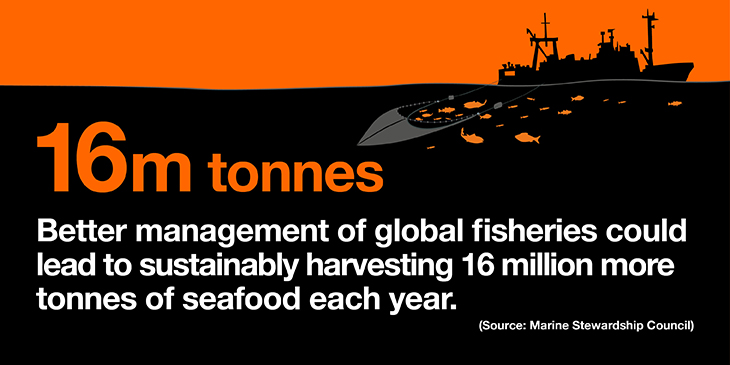Digital tools and sustainability
While seafood demand may be growing, there are increasing concerns about how this can be met sustainably. As a McKinsey article notes, “About half the world’s fish stocks are now classified as collapsed, rebuilding or over exploited, and wild-catch rates are falling in most regions.” These depleted stocks have led to both the introduction of increased regulation to counter over fishing in certain areas and fleets having to travel further to secure the same catch, which increases fuel consumption and makes it harder to keep emissions down. Consumer expectations for more sustainable sources of food are also growing, putting increased pressure on every part of the supply chain to be able to demonstrate how they are taking appropriate actions.

To address these challenges, many commercial fishing fleets are looking to digital technologies. Marine telematics can help assess asset efficiency, while remote route monitoring can help operations teams review fuel consumption and provide vessel masters with options for enhanced fuel efficiency, incorporating real-time current and weather data into route planning. Real-time digital catch monitoring and connected weighing can help both vessel crews and onshore teams review catches, ensure the right fish and seafood are being caught, and gather accurate data for quotas and compliance. GPS and vessel tracking systems ensure that a vessel’s location is transparent and meets regulations relating to fishing locations.
These solutions use technologies like the Internet of Things (IoT), artificial intelligence, edge computing and cloud applications to help operators improve operational sustainability.
Dobroflot, the Russian fishing fleet operator, is doing precisely that. It has been working with Orange Business to deploy an IoT fuel monitoring service to monitor all its vessels’ fuel consumption accurately, whether at sea, bunkering or refueling. This can directly impact the company’s bottom line, said Evgeny Stepanov, Dobroflot’s Chief Technology Officer. “Around half of a vessel’s operating costs are related to fuel. An active IoT system onboard our vessels will enable us to collect data in real-time and map the most efficient routes.” The insights gathered by the IoT system have allowed the company to reduce fuel consumption by up to 10%.
Connecting fleets across the seas
However, these innovations bring new challenges. Namely, how do you ensure constant connectivity to enable data sharing in real time in an environment far beyond the reaches of most communications networks?
This is a challenge the entire maritime sector faces, not just commercial fishing. Whether container or bulk freight, bunker or roll-on/roll-off, cargo owners expect to know where their shipments are at any given moment, while vessel operators need real-time data for both environmental and economic reasons.
Then there’s the question of crew welfare. Maritime in general has a talent issue – the long periods away from home and dangerous conditions make it a hard sell, particularly as education levels improve and alternative, easier jobs become available in traditional talent pools. The innovations in fishing production at sea may help speed up delivery of the product, but it also means fishing crews can be at sea for even longer than their peers working in ocean freight.
The pandemic has exacerbated the situation, ushering in a crisis where upwards of 300,000 seafarers across all sectors were stranded at sea as countries shut their borders and banned changeovers.
Digital connectivity can provide a much-needed welfare lifeline to seafarers in fishing, freight and other sectors spending months at sea. Those operators who can facilitate a remote link to friends and family, no matter which ocean the vessel is on, are more likely to have happier crews.
From floating local networks to satellite connections
One option is to create private networks onboard vessels using 5G. Already being deployed onshore with the likes of the Port of Antwerp to protect uptime and ensure security, ships would become floating local networks, ensuring that every device, whether on deck or in the depths of the engine room, would be able to share its data. Whether crew speaking to family from the privacy of their berths, or information being collected and shared sensors on machinery in the hold, the connections would be secure and reliable. No more manually gathering readings before taking them to a control room for input (and increasing the risk of human error), and no more having to take personal calls in common areas.
However, that is only half the battle. A local network needs a secure, reliable connection to the outside world. This is where employing maritime satellite solutions comes in. Using either very-small-aperture terminals (VSATs) or high-throughput satellites (HTS), fishing fleets can connect all their vessels with their corporate networks. Flexible bandwidth grouping and automatic beam switching (to keep the vessel connected as it moves out of and into the range of different satellites) mean that fleets can access higher speeds, lower latency and increased coverage, enabling the technologies needed to improve commercial fishing. Everything from business-critical applications to voice communication and entertainment services can be delivered to vessels, irrespective of location.
It’s certainly working for Dobroflot. Its IoT solution uses an Orange Business managed satellite solution to stay connected via onboard VSAT terminals to share data between its vessels and onshore operations. In addition, rather than a significant upfront investment, Dobroflot pays a monthly subscription for the service.
If commercial fishing is to become more sustainable, operators like Dobroflot know they need to connect their vessels to improve fuel efficiency, optimize their fleets and maintain crew morale. Combining 5G and VSAT offers them a way to do so with a secure, stable and reliable network.
For more information, read how Orange is expanding its partnership with SES Networks to deliver higher-capacity satellite connectivity services.